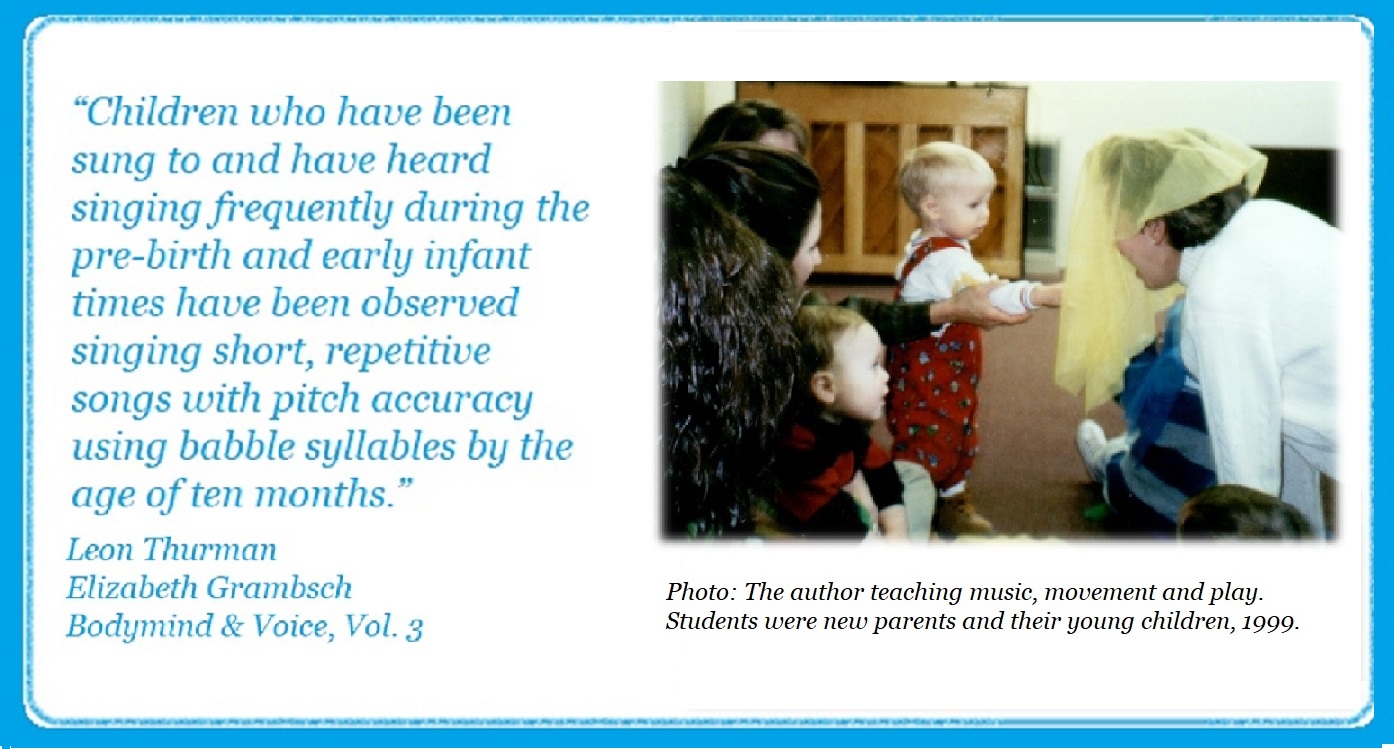Anyone who has heard a child improvise melodies from the crib knows it is a precious sound. Little ones can babble repetitive songs with pitch accuracy as early as the age of ten months. It’s likely these children have been sung to and/or have heard singing frequently during the pre-birth and early infant years. What are the basic requirements needed for children to learn to sing?
The physical ability to sing depends on the degree of normal and healthy development of the vocal mechanism (larynx, vocal folds, breathing apparatus), and on one’s neuro-biological ability to process music pitch.
In a 2006 study, a John’s Hopkins team studied marmoset monkeys using a technique that measures the electrical activity of individual neurons in the brain. The researchers viewed each neuron’s reaction as different notes were played by a computer. The researchers were able to discern that a majority of pitch-selective neurons are located in a specific region of the monkey’s brain near the primary auditory cortex, a region already known to interpret sounds.
“A tiny primate, the marmoset, appears to process pitch perception the same way we do, implying that the ability evolved in a common ancestor at least 40 million years ago.”
60-Second Science

“The auditory cortex has traditionally been thought to detect the complex spectrum contained within a sound; for example, they thought…one set of neurons responded only to a trumpet and another set to a violin, even if playing the same note,” says Wang. “But the neurons were found to respond to a single musical note, regardless if played by a trumpet or violin.”
What about pitch matching?
It has been observed there are a set of “pre-skills” a child must learn along the way to her being able to develop the ability to match pitch. Past research verifies the need for these skills:
- Children must develop awareness of the sensations of singing.
TO DO: Help discovery of these feelings by directing the child to feel the vibrations in her chest while vocalizing in various registers. Draw attention to the sensations of chanting and of singing. Rather than instructing or telling, discovery is the key here.
- Children must be able to verbally describe their own vocal sounds and that of others.
TO DO: Encourage children to distinguish between whispering, calling, singing and speaking.
- Children must be able to produce a variety of vocal registers and voice qualities.
TO DO: Experiment play with making environmental and animal sounds.
Range and Pitch Accuracy
“Children should not be expected to sing in the same ranges, with the same intensity, for the same periods of time as adults.” (Miller, Page 29)
Songs for children should be pitched to around D Major. Since many music textbooks have lowered the pitches of songs to middle C or below, teachers must re-pitch them to a higher key for vocal health and pitch accuracy reasons. Children age 5 or younger usually cannot sing a middle C without engaging in pressed phonation. Start songs in a narrow range: D4 to A4 is recommended for our youngest students. Assess development and then add B4 and C5. Prior to puberty: B-flat below middle C to E or F at top of treble clef are now the recommended limits for most children.
Kinesthetics and Pitch Accuracy
Many researchers recommend using movement to assist in learning pitch accuracy.
- TO DO: Use movement to describe high pitch and low pitch.
- TO DO: Encourage children to follow music contour though dance or movement of the arms and body.
- TO DO: Curwen Hand Signs can be used to associate movement with pitch.


By Scanned and enhanced by Matthew D. Thibeault – (Original text: John Curwen Standard Course (1904 edition, public domain))If the date is 1904, the author may be John Curwen (died 1880) or his son John Spencer Curwen (died 1916)., Public Domain, https://commons.wikimedia.org/w/index.php?curid=6874560
Most children are born with the physical ability to sing, and most children innately love playing with their voice. This is most likely true for children have been sung to and/or have heard singing frequently during the pre-birth and early infant years. Use your voice, and watch the precious vocal development of the young children you teach.
Article by Author Jamea J. Sale, MME, Education Director: JSale@ HealthySinging.org Institute for Healthy Singing with the William Baker Choral Foundation; Voice Specialist, Allegro Choirs of Kansas City
REFRENCES:
Bendor, D; Wang, X.(2005). The neuronal representation of pitch in primate auditory cortex. Nature. Vol. 436. pp. 1161-1165.
Bennett, P. (1986). A responsibility to young voices. Music Educators Journal, 73, 33–38.
Bertaux, B. (1989). Teaching children of all ages to use the singing voice, and how to work with out-of-tune singers. In D. L. Walters & C. C. Taggart (Eds.), Readings in music learning theory (pp. 92–104). Chicago: GIA Publications.
Marra, J. (2018). Research shows where brain interprets “Pitch”. Hopkinsmedicine.org. Retrieved from https://www.hopkinsmedicine.org/Press_releases/2005/09_06_05.html
Miller, R. (2004) Solutions for Singers: Tools for Performers and Teachers. Oxford University Press.
Mina, C. (2009). The Musical Development of the Child.
Mizener, C.P. (2008). Our Singing Children: Developing Singing Accuracy General Music Today, Vol. 21, 3: pp. 18-24.
Philips, K. (1992). Teaching Kids to Sing. Schirmer.
Thurman, L, Grambsch, E. (2002) Foundations for human self-expression during prenate, infant, and early childhood development. Bodymind & Voice, Vol. 3. VoiceCare Network, Collegeville, MN.
Trollinger, V. (2003). Relationships between Pitch-Matching Accuracy, Speech Fundamental Frequency, Speech Range, Age, and Gender in American English-Speaking Preschool Children. Journal of Research in Music Education, 51(1), pp. 78-94.


Stephanie Henry says
Excellent, accessible article. Thank you. I hope it gets wide readership!